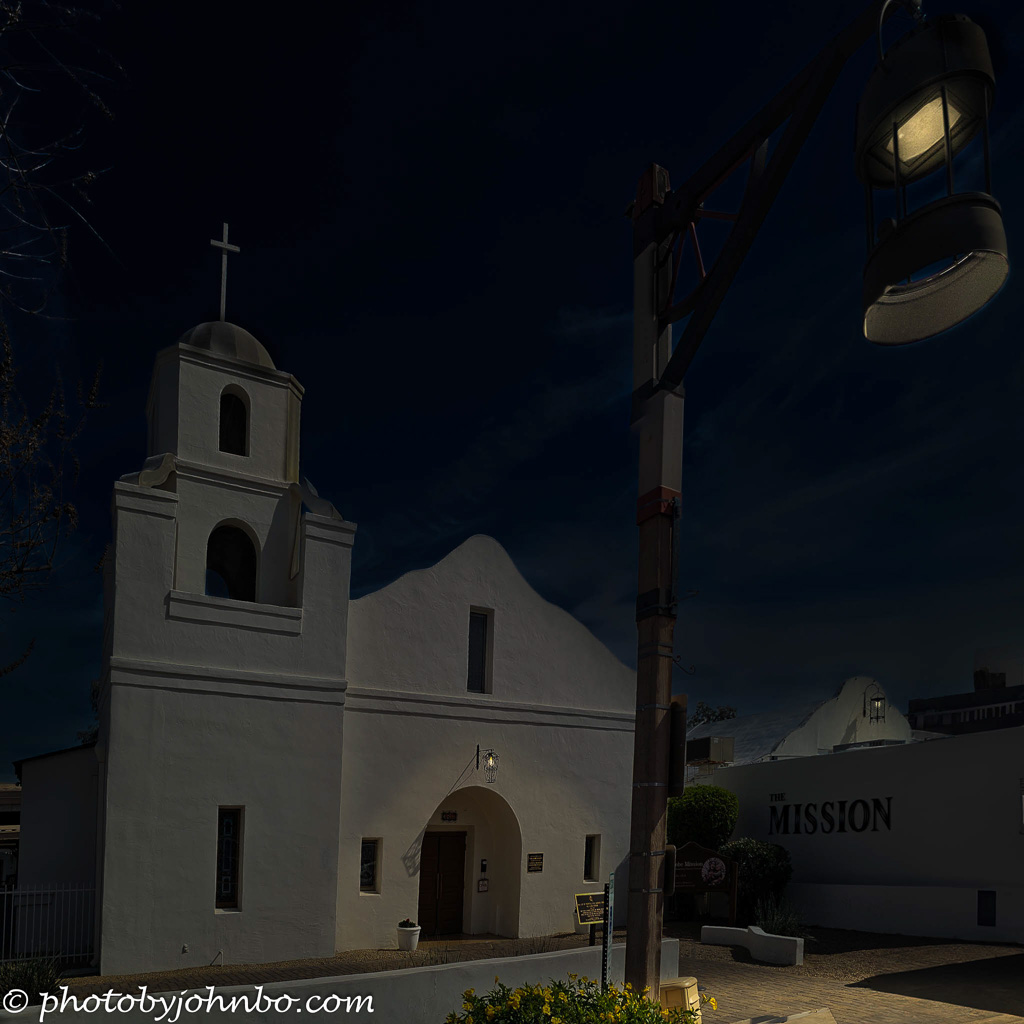
Scottsdale, Arizona.
First, a quick note: If everything goes as planned, today, we will begin traveling to a part of the world where Internet access is not guaranteed. With some 20 hours of flight time, International destinations, and limited WiFi for the next several days, I am not likely to reliably respond to comments and posts this week due to my lack of connectivity. More on that journey in the months to come.
It’s no secret to regular readers that I love to play at being a photo editor. My favorite tool for most work is Luminar Neo, but earlier this year, I discovered a YouTuber who posted many videos converting day images into nighttime scenes using Lightroom Classic. I’ve done this in the past with lighthouse photographs, but Jamie R. Mathlin taught me some tricks using Lightroom for lighting street lamps. But I’m getting ahead of myself.
First, a bit of history: The mission church in Old Town Scottsdale, Arizona, is called the Old Adobe Mission. It’s a historic landmark and the oldest standing church in Scottsdale. It was built in 1933 and was initially called Our Lady of Perpetual Help (OLPH) Catholic Church. Mexican settlers in the area hand-built it. The design is Spanish Colonial Revival, featuring over 14,000 adobe bricks.
About the photo: The church is on a busy street, and to avoid having parked cars block the view, I captured the image on a bright, sunny day in two photos from my Samsung S23U, one featuring the church entrance and the other at the top and bell tower. I used Adobe Lightroom Classic to merge the images into a panorama.
Due to the closeness of my camera’s viewpoint and my need to include the streetlamp in the foreground, the image needed a lot of geometric correction. Information at the extreme left and right of the photo was clipped in the panorama Lightroom created, so I used Photoshop’s Generative Fill to fill in the missing areas. I then cropped the image into a square format.
Mr. Mathlin’s videos for day-to-night conversion are typically between 45 minutes and an hour, and he’s experienced, so I expected my conversion would take quite a bit longer. It turned out to be about 90 minutes from start to finish.
I will not bore you with specifics on the technique; Mr. Mathlin is much better at demonstrating that in a video than I could be in the text here. I will say that the strong Arizona sunlight and bright blue sky made the image more challenging to appear dark. I settled for pretending it was at the blue hour just before dark. I noted three visible lamps in the photo that needed to be illuminated. I started with the street lamp, then moved to the light above the church entrance, then to the lamp on the building next door. To view the image in 2K HD on a dark background, click on it.
I encourage fellow bloggers to create their own Cellpic Sunday posts. I never have a specific topic for this feature, and the only rules are that the photo must be captured with a cell phone, iPad, or another mobile device… If you have an image from a drone or even a dashcam, that’s also acceptable. The second rule is to link your challenge response to this post or leave a comment here with a link to your post in the comment. Oh, you don’t have to post it on a Sunday.
John Steiner


Happy Sunday 🙂
Cellpic Sunday – Cremyll – Ladyleemanila (wordpress.com)
You did have fun John. I wouldn’t have the patience for a process that long.
Something different from me this week
It is relaxing, if there aren’t too many lights. In a future post, I share one that got a bit tedious. 🙂
Interesting. And well done! Here is my Sunday on cell:
https://picturesimperfectblog.com/2024/09/29/the-town-council-was-fed-up/
Thanks!
I would have never guessed that you didn’t photograph this at night, John! I always appreciate your editing processes! Enjoy your travels! I have some oddballs and weird objects this week!
https://secondwindleisure.com/2024/09/29/sunday-stills-a-world-of-weird-wild-and-oddballs/
Thanks, Terri!
Like Terri said, an impressive transformation, John 👏 Safe Travels 😃 Here’s mine: https://jezbraithwaite.blog/2024/09/30/hamilton-mausoleum-cellpic-sunday/
I like this edit John!
Enjoy your travels to our part of the world!
https://judydykstrabrown.com/2024/09/30/portal-for-cellpic-sunday-sept-29-2024/